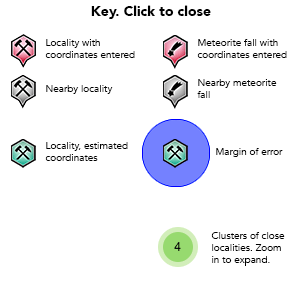Red Hill Mine (The Welcome Nugget), Bakery Hill, City of Ballarat, Victoria, Australia

| Latitude & Longitude (WGS84): | 37° 33' 38'' South , 143° 51' 59'' East |
|---|---|
| Latitude & Longitude (decimal): | -37.56061,143.86649 |
| GeoHash: | G#: r1q63f23s |
| Köppen climate type: | Cfb : Temperate oceanic climate |
At the time of writing the Welcome Nugget is the second largest nugget found anywhere in the world at 2217 ounces (99.6% pure gold), only eclipsed eleven years later by the Welcome Stranger Nugget, also found in Victoria.
In 1857, twenty-two Cornish miners who had worked in copper mines left Swansea to seek their fortune on the Victorian goldfields. They were Richard Layon, Stephen Garthew (Carthew), William Treloar, William Jeffery, James Oliver, Anthony Guard, James Gundery (Gundrey), Richard Jeffery, William Thomas, John Thomas, Bennet Andrews, Henry Andrews, Philip Mathews, Richard Mitchell, Henry Harris, William Roberts, William Hampton, William Treganza, Francis Webster, James Thomas Sleman (Sleeman), John Caunter, and William Laity. (www.ballaratgenealogy.org). (Other sources may have slightly different spellings for some names).
After an unsuccessful attempt at mining at Creswick, they moved to Ballarat, taking up an old alluvial claim at the corner of what is now Humffray and Mair streets, abandoned as worthless by two prior parties. The working miners formed themselves into the Red Hill Co-operative Gold Mining Company, and prior to the Welcome Nugget worked the claim for eight months finding several nuggets from 12 to 45 ounces each. They were the first to introduce steam powered machinery to the Ballarat goldfield.
The nugget was uncovered by Richard Jeffery 09 June 1858 (majority sources, some say 8th, some 10th). Jeffery was picking at wash dirt in the roof of a tunnel, when it struck something un-movable and glittering in the dim light. The nugget was heaved to the surface and carted back to Jeffery's house in a wheelbarrow, and stored overnight in the oven.
After being displayed in Ballarat and Melbourne, the nugget was sold to the Wittkowski brothers (Julius, Isiodor, Joseph). The brothers decided to make money from the nugget by offering it as first prize in a monster lottery, along with the Nil Desperandum nugget 540 ounces found at Little Bendigo 28 November 1857, and several smaller nuggets as minor prizes. Illustrated pamphlets were distributed across Australia, England and Europe, until the government stopped the lottery. Overseas agents kept the money paid for the tickets, and the brothers lost much money.
The nugget was sold to a Professor Anderson, showman and conjurer, possibly Scottish born John Henry Anderson, a well known and successful magician at the time. The nugget was displayed at Crystal Palace, before being sold to the English Royal Mint who melted the nugget down for sovereigns.
What happened to the Cornish miners is not recorded apart from passing mentions decades later of whom was still alive. The one exception is Francis Webster, who lived a vagrant lifestyle still searching for the next big find. In old age, and of unstable mind, he was found wandering without clothes near the site of the original find in 1907. He was committed to a benevolent asylum where he died in 1909.
A small granite monument erected in 1934 marks the spot of the find. A model of the nugget is displayed at the Gold Museum (and several other museums worldwide), opposite Sovereign Hill in Ballarat.
Select Mineral List Type
Standard Detailed Strunz Dana Chemical ElementsDetailed Mineral List:
| ⓘ Gold Formula: Au Reference: The Brisbane Courier newspaper (1868) The Finding of the Welcome Nugget, 22 February 1868. |
List of minerals arranged by Dana 8th Edition classification
| Group 1 - NATIVE ELEMENTS AND ALLOYS | |||
|---|---|---|---|
| Metals, other than the Platinum Group | |||
| ⓘ | Gold | 1.1.1.1 | Au |
Regional Geology
This geological map and associated information on rock units at or nearby to the coordinates given for this locality is based on relatively small scale geological maps provided by various national Geological Surveys. This does not necessarily represent the complete geology at this locality but it gives a background for the region in which it is found.
Click on geological units on the map for more information. Click here to view full-screen map on Macrostrat.org
| Holocene 0 - 0.0117 Ma ID: 859805 | alluvium 38485 Age: Anthropocene (0 - 0.0117 Ma) Description: Channel and flood plain alluvium; gravel, sand, silt, clay; may be locally calcreted Comments: regolith; synthesis of multiple published descriptions Lithology: Regolith Reference: Raymond, O.L., Liu, S., Gallagher, R., Zhang, W., Highet, L.M. Surface Geology of Australia 1:1 million scale dataset 2012 edition. Commonwealth of Australia (Geoscience Australia). [5] |
| Early Silurian - Cambrian 427.4 - 541 Ma ID: 3185333 | Paleozoic sedimentary rocks Age: Paleozoic (427.4 - 541 Ma) Comments: Lachlan Fold Belt Lithology: Sedimentary rocks Reference: Chorlton, L.B. Generalized geology of the world: bedrock domains and major faults in GIS format: a small-scale world geology map with an extended geological attribute database. doi: 10.4095/223767. Geological Survey of Canada, Open File 5529. [154] |
Data and map coding provided by Macrostrat.org, used under Creative Commons Attribution 4.0 License



